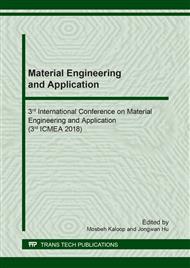[1]
D. R. Askeland, P. Phule, The Science and Engineering of Materials, Cengage Learning, Singapore, (2006).
Google Scholar
[2]
S. J. Doshi, A. V Gohil, N. D. Mehta, S. R. Vaghasiya, Challenges in Fusion Welding of Al alloy for Body in White, Mater. Today: Proc. 5 (2018) 6370-6375.
DOI: 10.1016/j.matpr.2017.12.247
Google Scholar
[3]
R. Nandan, T. DebRoy, H. K. D. H. Bhadeshia, Recent advances in friction-stir welding – Process, weldment structure and properties, Prog. Mater. Sci. 53 (2008) 980-1023.
DOI: 10.1016/j.pmatsci.2008.05.001
Google Scholar
[4]
V. Infante, D. F. O. Braga, F. Duarte, P. M. G. Moreira, M. de Freitas, P. M. S. T. de Castro, Study of the fatigue behaviour of dissimilar aluminium joints produced by friction stir welding, Int. J. Fatigue, 82 (2016) 310-316.
DOI: 10.1016/j.ijfatigue.2015.06.020
Google Scholar
[5]
U. Das, V. Toppo, Effect of Tool Rotational Speed on Temperature and Impact Strength of Friction Stir Welded Joint of Two Dissimilar Aluminum Alloys, Mater. Today: Proc. 5 (2018) 6170-6175.
DOI: 10.1016/j.matpr.2017.12.223
Google Scholar
[6]
N. Z. Khan, A. N. Siddiquee, Z. A. Khan, S. K. Shihab, Investigations on tunneling and kissing bond defects in FSW joints for dissimilar aluminum alloys, J. Alloys. Compd. 648 (2015) 360-367.
DOI: 10.1016/j.jallcom.2015.06.246
Google Scholar
[7]
M. Ilangovan, S. R. Boopathy, V. Balasubramanian, Microstructure and tensile properties of friction stir welded dissimilar AA6061–AA5086 aluminium alloy joints, Trans. Nonferr. Metal. Soc. China, 25 (2015) 1080-1090.
DOI: 10.1016/s1003-6326(15)63701-3
Google Scholar
[8]
D. Devaiah, K. Kishore, P. Laxminarayana, Optimal FSW process parameters for dissimilar aluminium alloys (AA5083 and AA6061) Using Taguchi Technique, Mater. Today: Proc. 5 (2018) 4607-4614.
DOI: 10.1016/j.matpr.2017.12.031
Google Scholar
[9]
R. Srinivasan, A. Ramesh, A. Athithanambi, Effect of Axial Force on Microstructure and Mechanical Properties Of Friction Stir Welded Squeeze Cast A413 Aluminium Alloy, Mater. Today: Proc. 5 (2018) 13486-13494.
DOI: 10.1016/j.matpr.2018.02.344
Google Scholar
[10]
M. S. Rizi, A. H. Kokabi, Microstructure evolution and microhardness of friction stir welded cast aluminum bronze, J. Mater. Proc. Technol. 214 (2014) 1524-1529.
DOI: 10.1016/j.jmatprotec.2014.02.017
Google Scholar
[11]
A. M. Dubey, A. Kumar, A. K. Yadav, Wear behaviour of friction stir weld joint of cast Al (4–10%) Cu alloy welded at different operating parameters, J. Mater. Proc. Technol. 240 (2017) 87-97.
DOI: 10.1016/j.jmatprotec.2016.09.003
Google Scholar
[12]
K. Sadmai, J. Kaewwichit, W. Roybang, N. Keawsakul, K. Kimapong, Microstructure and Tensile Strength of Butt Joint between AA6063 Aluminum Alloy and AISI304 Stainless Steel by Friction Stir Welding, Int. J. Adv. Cult. Technol. 3 (2015) 179-187.
DOI: 10.17703/ijact.2015.3.1.179
Google Scholar
[13]
S. Zhang, Q. Shi, Q. Liu, R. Xie, G. Zhang, and G. Chen, Effects of tool tilt angle on the in-process heat transfer and mass transfer during friction stir welding, Int. J. Heat. Mass Transf. 125 (2018) 32-42.
DOI: 10.1016/j.ijheatmasstransfer.2018.04.067
Google Scholar
[14]
G. E. Dieter, Mechanical Metallurgy, McGraw-Hill Book Company, Singapore, (1988).
Google Scholar
[15]
S. Zhang, G. Chen, Q. Liu, H. Li, G. Zhang, G. Wang et al., Numerical analysis and analytical modeling of the spatial distribution of heat flux during friction stir welding, J. Manuf. Process. 33 (2018) 245-255.
DOI: 10.1016/j.jmapro.2018.05.021
Google Scholar
[16]
E. Sharghi, A. Farzadi, Simulation of strain rate, material flow, and nugget shape during dissimilar friction stir welding of AA6061 aluminum alloy and Al-Mg2Si composite, J. Alloys. Compd. 748 (2018) 953-960.
DOI: 10.1016/j.jallcom.2018.03.145
Google Scholar


